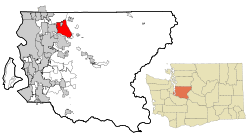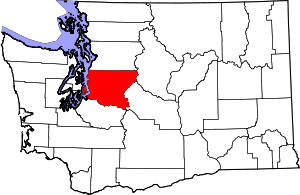Union Hill-Novelty Hill, Washington
Union Hill-Novelty Hill is a census-designated place (CDP) in King County, Washington, United States. The area was first recognized by the Census Bureau in the 2000 census. The population was 18,805 at the 2010 census.[3]
Union Hill-Novelty Hill, Washington | |
|---|---|
 Location of Union Hill-Novelty Hill, Washington | |
| Coordinates: 47°40′43″N 122°2′57″W | |
| Country | United States |
| State | Washington |
| County | King |
| Area | |
| • Total | 24.32 sq mi (62.98 km2) |
| • Land | 24.23 sq mi (62.75 km2) |
| • Water | 0.09 sq mi (0.23 km2) |
| Elevation | 515 ft (157 m) |
| Population (2010) | |
| • Total | 18,805 |
| • Density | 776/sq mi (299.7/km2) |
| Time zone | UTC-8 (Pacific (PST)) |
| • Summer (DST) | UTC-7 (PDT) |
| FIPS code | 53-73307[1] |
| GNIS feature ID | 2409379[2] |
Based on per capita income, Union Hill-Novelty Hill ranks 5th of 522 areas in the state of Washington to be ranked.
Geography
Union Hill-Novelty Hill is located in northern King County at 47°40′43″N 122°2′57″W (47.678674, −122.049198).[4] It is bordered to the west by the city of Redmond, and a separate portion of the city, comprising the Redmond Watershed Preserve, is surrounded by the northern part of the CDP. To the north is the Cottage Lake CDP, and Washington State Route 202 runs along the southern edge of the community in the valley of Evans Creek and Patterson Creek. The Ames Lake CDP is to the southeast, and downtown Seattle is 20 miles (32 km) to the southwest.
According to the United States Census Bureau, the Union Hill-Novelty Hill CDP has a total area of 24.3 square miles (63.0 km2), of which 24.2 square miles (62.8 km2) are land and 0.1 square miles (0.2 km2), or 0.36%, are water.[3]
Demographics
As of the census[1] of 2000, there were 11,265 people, 3,584 households, and 3,103 families residing in the CDP. The population density was 462.9 people per square mile (178.7/km²). There were 3,677 housing units at an average density of 151.1/sq mi (58.3/km²). The racial makeup of the CDP was 90.77% White, 0.78% African American, 0.39% Native American, 4.25% Asian, 0.06% Pacific Islander, 1.30% from other races, and 2.45% from two or more races. Hispanic or Latino people of any race were 3.45% of the population.
There were 3,584 households out of which 53.4% had children under the age of 18 living with them, 78.7% were married couples living together, 4.9% had a female householder with no husband present, and 13.4% were non-families. 9.0% of all households were made up of individuals and 2.0% had someone living alone who was 65 years of age or older. The average household size was 3.14 and the average family size was 3.37.
In the CDP the population was spread out with 33.3% under the age of 18, 5.1% from 18 to 24, 31.2% from 25 to 44, 26.0% from 45 to 64, and 4.3% who were 65 years of age or older. The median age was 36 years. For every 100 females there were 106.7 males. For every 100 females age 18 and over, there were 102.5 males.
The median income for a household in the CDP was $98,061, and the median income for a family was $105,758. Males had a median income of $77,954 versus $46,167 for females. The per capita income for the CDP was $58,285. About 2.3% of families and 2.9% of the population were below the poverty line, including 2.6% of those under age 18 and 3.5% of those age 65 or over.
References
- "U.S. Census website". United States Census Bureau. Retrieved 2008-01-31.
- "Union Hill-Novelty Hill Census Designated Place". Geographic Names Information System. United States Geological Survey.
- "Geographic Identifiers: 2010 Census Summary File 1 (G001), Union Hill-Novelty Hill CDP, Washington". American FactFinder. U.S. Census Bureau. Archived from the original on February 13, 2020. Retrieved June 21, 2019.
- "US Gazetteer files: 2010, 2000, and 1990". United States Census Bureau. 2011-02-12. Retrieved 2011-04-23.
